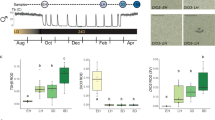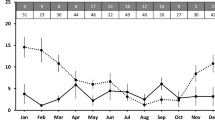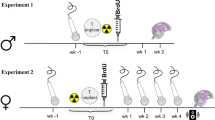Abstract
Embryonic diapause is a widespread phenomenon in mammals and may be controlled either by lactation or by seasonal environmental factors1. A few species, such as the tammar wallaby, Macropus eugenii, use both mechanisms, depending on the time of year. On Kangaroo Island, South Australia (latitude 36° S), female tammars give birth to a single young in late January or early February2. Mating occurs on the day after birth and the resulting conceptus grows to a 100-cell blastocyst before entering a state of embryonic diapause. This arrest of embryonic growth is due to a suppression of the corpus luteum by prolactin induced by the young in the pouch sucking the teat (lactational diapause)3,4. If the young is removed from the teat between February and early June, the corpus luteum hypertrophies, the blastocyst resumes growth and birth occurs 27 days later5. In the second half of the year (June to December), diapause is not solely dependent on the sucking stimulus as it is maintained after weaning, which usually occurs in October, or following experimental removal of the pouch young. This is referred to as seasonal diapause5. Reactivation occurs on or about the summer solstice (22 December) and there is evidence that it is photoperiodically induced6 (Fig. 1). We report here that bilateral removal of the superior cervical ganglion in female tammars eliminates seasonal embryonic diapause, but has no effect on lactational diapause. This is the first evidence that the pineal gland may be involved in regulation of embryonic diapause in mammals.
This is a preview of subscription content, access via your institution
Access options
Subscribe to this journal
Receive 51 print issues and online access
$199.00 per year
only $3.90 per issue
Buy this article
- Purchase on Springer Link
- Instant access to full article PDF
Prices may be subject to local taxes which are calculated during checkout
Similar content being viewed by others
References
Flint, A. P. F., Renfree, M. B. & Weir, B. J. J. Reprod. Fert. Suppl. 29 (1981).
Renfree, M. B. & Tyndale-Biscoe, C. H. Devl Biol. 32, 28–40 (1973).
Renfree, M. B. Nature 293, 100 (1981).
Tyndale-Biscoe, C. H. in Endocrinology 1980 (eds Cumming, I. A., Funder, J. W. & Mendelsohn, F. A. O.) 277–282 (Australian Academy of Science, Canberra, 1980).
Tyndale-Biscoe, C. H., Hearn, J. P. & Renfree, M. B. J. Endocr. 63, 589–614 (1974).
Sadleir, R. M. F. S. & Tyndale-Biscoe, C. H. Biol. Reprod. 16, 605–608 (1977).
Rollag, M. D. & Niswender, G. D. Endocrinology 98, 482–489 (1976).
Hearn, J. P. Nature 241, 207–208 (1973).
Tyndale-Biscoe, C. H. & Hinds, L. J. Reprod. Fert. Suppl. 29, 111–118 (1981).
Vaughan, M. I., Blask, D. E., Johnson, L. Y. & Reiter, R. J. Endocrinology 104, 212–217 (1980).
Buttle, H. L. Neuroendocrinology 23, 121–128 (1977).
Lincoln, G. A. Acta endocr., Copenh 91, 421–427 (1979).
Author information
Authors and Affiliations
Rights and permissions
About this article
Cite this article
Renfree, M., Lincoln, D., Almeida, O. et al. Abolition of seasonal embryonic diapause in a wallaby by pineal denervation. Nature 293, 138–139 (1981). https://doi.org/10.1038/293138a0
Received:
Accepted:
Issue Date:
DOI: https://doi.org/10.1038/293138a0
This article is cited by
-
Marsupials: alternative mammals
Nature (1981)
Comments
By submitting a comment you agree to abide by our Terms and Community Guidelines. If you find something abusive or that does not comply with our terms or guidelines please flag it as inappropriate.



